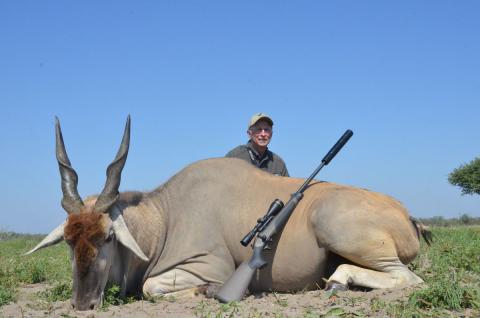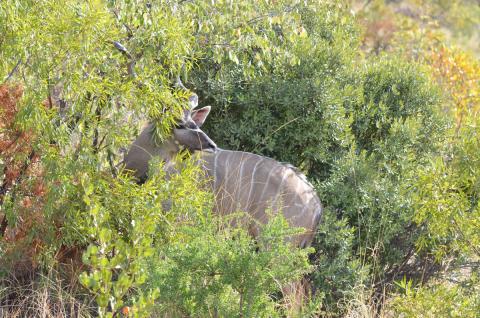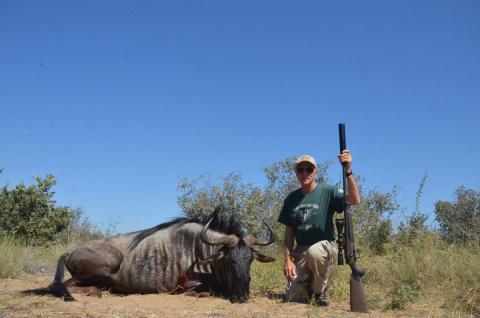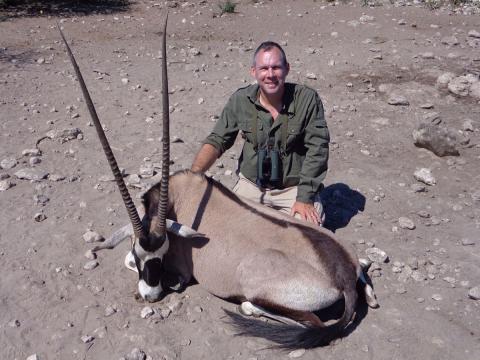Botswana Plains Game Hunt Extraordinaire

Botswana is an extraordinary place to hunt plains game in Africa today. Why? Because eland, kudu and gemsbok grazing on massive ranches in the Kalahari went virtually untouched while elephant, lion and Cape buffalo were the country's main drawing cards. Things changed in 2014 when the government moratorium on hunting was instituted. The one exception to the hunting ban was that plains game on some private lands remained open to hunting. I sought out Botswana safari operator Clive Eaton of Tholo Safaris at the SCI Hunters’ Convention to get the lowdown and plan an eland hunt.
Eaton had registered his ranch in 1990 under the fledgling government game ranch provision. Ranches registered under that provision are still open to hunting. His 220,000-hectare ranch in the Kalahari has abundant herds of plains game. I wanted to hunt eland in the Kalahari and the wild conditions and his massive ranch lands fit perfectly. I booked a hunt and so did my hunting partner, Brian Lynch.
Since I was going to spend time and money in a country that banned hunting, I researched the situation. To my surprise I discovered an article in the New York Times chronicling how hunting was a main economic driver of conservation in Botswana and hunters were still very welcomed. Not only did the article question the ban from economic, social and wildlife conservation angles, it talked of hardships already occurring in smaller villages from the ban. Money did not seem to be trickling down from the new photographic economy to native communities that lived on the edge of poverty and dealt with crop raiding elephants and rogue lions. It sounded too familiar.[
Four months after talking with Eaton, Brian and I were on an Air Botswana flight into Maun, Botswana and eland were on the top of our list. Once we had a mature eland, we would move on to kudu, gemsbok and blue wildebeest. A mature bull eland topped my list with a kudu in the mid 50 inches range a close second. Brian prized an eland and really wanted a 40-inch gemsbok.
The following morning at sunrise, each of us climbed into Land Rovers with our professional hunters and drove off in opposite directions. As we bumped along sand tracks and rutted trails, my PH, Riaan Taljaard, explained that once we cut a good set of bull eland tracks we would get out and track them through the bush until we got a good enough look to judge the quality of the bull. The bush was dense on this part of the 220,000-hectare ranch. Rains had just stopped and standing pools of water dotted low-lying areas. My visions of the sands of the Kalahari did not include lots of green and standing water.

Riaan also warned that they were seeing more snakes than usual as they were seeking high ground. Snakes? “Exactly what kind of snakes?” I asked. “Mambas, puff adders and other assorted snakes,” he nonchalantly answered. I went on high alert; black mambas are the largest venomous snake in Africa with adults reaching average length of eight feet and kill the most humans.
Bouncing along in the Land Rover the country seemed to go on endlessly, sand roads stretched for miles cutting through a series of small savannas hedged in by walls of green. The record 11 inches of rain that poured down a week earlier started a new cycle of plant bloom and the new collage of green would make getting a clean shot a challenge.
Over the next several hours, we stopped three times while trackers and PH conferred over eland spoor. On our way to check a waterhole for tracks, a jackal crossed ahead of us, stopping 100 yards away behind a small bush. Riaan quipped, “Jackals are free, but if you miss we add $100 to your bill.” I took the challenge and soon the tracker was inspecting a dead jackal. I was using one of Tholo Safaris's Blaser .300 Win. Mag. loaner rifles with a Leupold 2-8x scope. Loaded with a 200-grain bullet, it was accurate and deadly. If an animal was wounded or missed it was on me.
We found the track of a big eland bull with several smaller bulls and were out tracking. It was apparent that we were losing ground as they moved at a steady gait we could not match. Two hours later, we halted and Riaan whispered that the eland would lie down soon. An hour later, we caught up to them. They bedded in thick bush and we closed within 30 feet. We could hear them scratching an itch, shifting positions and an occasional loud grunt, but could not see them. Using sign language, our tracker indicated we should wait while he worked to find a sight line through the vegetation to judge their horns. Minutes later, he was back, gesturing that one was indeed a very big bull but it was laying next to a smaller bull which blocked a clean shot.
A slight shift in the wind gave away our position and bulls moved out silently with only the clicking of their heels to be heard. The tracker took us to their beds and we placed our hands on the still warm sand. Close.
Over lunch, Brian and I compared our experiences of getting close in dense brush but not seeing an animal. How could that be? They stand head high and some weigh more than 2,000 pounds. How could two or three of these giants just vanish? As the hunt wore on, it sunk in just how elusive eland hunting was. We covered miles on foot each day, seeing numerous blue wildebeest, gemsbok and kudu, but not getting the right shot on a mature bull eland.
Over the first three days, I passed up shots on several kudu in the 50- to 55-inch range. They were gorgeous. Was I making a major error? I had passed up five kudu bulls as big or bigger than the biggest one I had shot over six different plains game hunts in South Africa and Namibia. In the camp drying shed, a 60-inch kudu and two 55-inchers were propped against the wall, taken on the hunt before us. Kudu rut was in full swing, but when it ended, so might these magic kudu moments.
Brian and I had two blue wildebeest on our cards and each of us took one over the first three days. Our PHs knew where trophy bulls patrolled their territories and we glassed each time we passed through one. Spotting the right bull was a challenge since we only got quick glances of wildebeest moving in and out of dense green foliage.
Inspecting one bull’s territory, we got a quick look at him and took up the chase. When we closed in, all I could see was the neck through tangled vegetation. Riaan’s slight nod of his head indicated this was a shooter. I put crosshairs on its neck and squeezed the trigger. It was a dandy bull with thick bases and horns that curled out beyond its ears. That morning Brian also shot a trophy quality blue wildebeest just after leaving camp, so we compared notes over lunch.
The area was alive with game but the dense foliage made getting a clear shot difficult. We just had to be patient and take the opportunities that came our way.
A day later, my luck changed. A herd of wildebeest burst out of the brush and dashed in front of us. Behind them came a herd of eland, all cows except for one big bull. The wildebeest stopped and so did the eland behind them. Riaan immediately flipped open the sticks and said to take the bull. Seconds later a fine bull eland was mine. We were elated with the thick gnarly horns and the bluish cast to its hide and dewlap. It was exactly what I was after.
Back at camp, there were high fives all around. The tracker and skinners looked forward to dinners of tripe, their Kalahari special treat. I wanted a tenderloin to grill. At the skinning and cool storage shed I marveled at how expertly and quickly they processed the massive animal. The meat was headed to market 250 kilometers away to feed the upscale safari camps that had replaced the hunting concessions in the Okavango Delta. Pretty ironic.
That night around the campfire was full of stories about modern day lion and elephant hunting. Tholo Safari and Clive Eaton had guided several of my friends over the past 20 years on dangerous game hunts in the Delta. Hunting had accomplished the twin goals of generating income and protecting wild animals. Now elephants and lions were harassing villagers and are considered a nuisance and a danger. Locals were hunting wildlife for food and killing them to defend homeland and crops. Just maybe, the recent reversals of the hunting bans in Zambia recreating a positive flow of goods, services and money to local communities along with protecting wildlife would act as an example to Botswana.
The next day, Brian doubled up on a mature eland and trophy gemsbok. In the morning after four hours of tracking, the eland stopped in a small opening, providing Brian a shot at 100 yards. His .375 did the job and the meat truck was called in. It took three men almost two hours to cut a path through the brush to the eland. The converted Land Rover had dents and scratches from bumper to bumper.
Now we focused on kudu. On the evening hunt we drove up on a herd of kudu. There was an excellent 53 to 55-inch bull in the herd, according to Riaan. We climbed out of the truck and stalked him. Suddenly he was gone. I will carry the image of the giant bull with dark curling horns and a full main forever in my mind’s eye. I wanted a stalk where the animal had the chance to out fox us, and he did!
The next morning, walking into a grassy savanna area, we spooked a nice bull. We ran right, trying to catch a glimpse of him. The bull cut back through the brush toward us on a collision course. He screeched to a halt 10 yards away. Riaan shook his head no, and in seconds the package of muscle wheeled and was gone. Looking a kudu in the eye at 30 feet, the size and raw power of the animal is stunning.

Back at camp I was telling Brian of the encounter when he smiled and said to follow him. At the skinning shed, he pointed to his 56-inch kudu. Gorgeous is the only way to describe the long black curling horns. I could not wait to get back to hunting.
That evening, we located another mature kudu bull. Stalking through a dense opening I caught a glimpse of kudu horn racing above thick brush, then the body materialized and a nice bull stopped in a small opening. Before I could get him in the scope, he vanished. This was amazing hunting.
The next morning we checked a waterhole and found a herd of gemsbok. They were returning to the dense brush to bed. Riaan knew where they would cross an opening and we hustled to a small ironwood tree where he set up the sticks. The gemsbok herd walked through the opening and Riaan said to take the third one. The 200-grain bullet flight was true and the bull was mine. His big bases and long horns were exactly what I hoped for.
Back at the skinning shed, Brian admired my bull. Then he motioned to the zebra being skinned. The fine stallion appeared out of a small opening and Brian didn't hesitate. The rug was headed to his den.
Time was running out. I had passed up more mature kudu than I had seen on numerous other safaris. It was a luxury I had never experienced. We encountered numerous eland bulls. The accommodations were excellent and equipment first class from Land Rovers to rifles. Seeing the end of this hunt nearing was deflating.
Did I shoot the 60-inch kudu the last day for a storybook ending? No, but I took a fine mature bull and I am going back. Where else can you hunt eland, see more than 25 mature kudu bulls and pass up a Rowland Ward gemsbok?–Harry Morse



